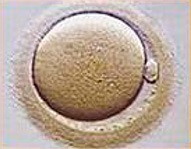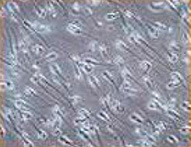Human Reproduction
Development of Germ Cells
The development of eggs start in the female uterus. A female newborn infant is born with 2-3 million eggs but the number of eggs will be reduced to around 400 thousand when she reaches puberty. Eggs are stored in the ovaries in the ovarian structures called follicles.
Eggs remain at rest during a certain period of their development until puberty. However; since the release of hormones in the body increases with the onset of puberty, the release of GnRH (Gonadotropin-releasing hormone) from a specific region part of the brain called hypothalamus and FSH (Follicle-stimulating hormone) and LH (Luteinizing hormone) from the pituitary gland start.

Egg (oocyte)

Sperm
The follicle-stimulating hormone (FSH), which stimulates the follicles containing the germ cells, resumes the egg development process after a pause, allowing eggs (oocytes) to reach maturity so that they can be fertilized by a sperm. The FSH hormone also stimulates the follicular cells surrounding the egg, resulting in the secretion of the hormone estrogen, which is a major hormone for the development of eggs. The follicles reach a a size of 1-2 mm to 20-25 mm in diameter under the influence of the FSH hormone. When they become this large, the so called ovulation occurs meaning that the follicle ruptures releasing the egg. Ovulation usually occurs on the 14th or 15th days of the menstrual cycle in women with regular menstrual cycles, that is women having their periods every 28-30 days.
With the start of the menstrual bleeding, 5-10 of the follicles in the ovaries begin to grow. Each month, only one of these eggs will grow adequately and will be ready to be fertilized by the sperm under the influence of the FSH hormone. As menopause approaches, a reduction occurs in the number of ovarian follicles. When all of the follicles are consumed, the period called menopause occurs.
Unlike women, sperm generation begins with puberty in boys. Likewise, the hormones FSH and LH are secreted in the male body, which act on the testicles and allow the generation and maturation of sperm cells. The hormone testosterone, secreted under the effects of FSH and LH, is the basic hormone that allows the generation and maturation of sperms.
Fertilization
The muscle contractions along the tubes and the movements of the parts of the tubes adjacent to the ovaries, the ovulated egg is taken into the tube. After the sexual intercourse, sperm cells start their journey from the vagina to reach the uterus. From the uterus, they arrive at the tubes and fertilize the egg. Sperms and eggs can survive in the female genital tract for 24 hours. The fertilized egg can reach the intrauterine cavity in approximately 3-4 days by means of the rhythmic contractions of the ovarian tubes. During this period, the cells of the fertilized egg multiply via division and increase in number. When the embryo reaches the intrauterine cavity, it will have approximately 16 cells. The blastocyst is a more developed embryo, which is ready for implantation in the intrauterine cavity.
Implantation
One of the most important factors necessary for a healthy implantation process (embryo's attachment into the intrauterine cavity) is the readiness of the endometrium; which is the internal lining of the uterus. When the embryo attaches to the lining of the uterine cavity, it continues its development and forms the fetus.